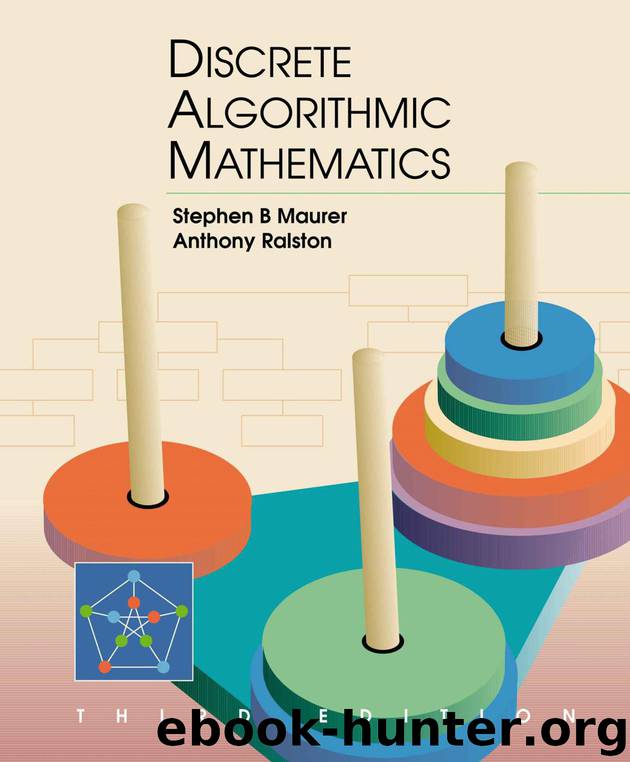Discrete Algorithmic Mathematics, Third Edition by Maurer Stephen B

Author:Maurer, Stephen B. [Maurer, Stephen B.]
Language: eng
Format: epub
Publisher: A K Peters/CRC Press
Published: 2013-05-17T04:00:00+00:00
386
Chapter 4
Fundamental Counting Methods
for each possible tour. If the cities (other than the salesman’s home city) are la-
beled 1 through n, then there is a one-to-one correspondence between tours and
permutations of 1 to n. For instance, if n = 5, the tour
home, city 2, city 4, city 3, city 5, city 1, home
corresponds to the permutation 24351. So the first step in the brute force approach
of Section 4.2 is to generate all the permutations.
We pointed out that, for n = 50, this approach is well beyond the capacity
of any computer. So what do you do? One alternative is to look for algorithms
which run quickly and find near-optimal solutions. One such algorithm is to choose
a random selection of tours and find the shortest among them. (Random means
that each possible tour is equally likely to be chosen.) This shortest tour among
those chosen probably won’t be the best of all, but in general it will be close to
best. To see this, first suppose you found just one random tour. On average, in
the ranking of all tours from best to worst it would be right in the middle. (For
instance, if there were just three tours and you picked one at random, 1/3 of the
time you would pick the best tour, 1/3 of the time you would pick the second best,
and 1/3 of the time you would pick the worst, so on average you would pick the
second best.) If you found exactly two tours at random, it should be plausible that
the better of them would be, on average, 1/3 of the way down the ranking from
best to worst. Indeed, if you choose n things at random from a collection of N
things, the average rank of your best choice is approximately 1 /( n+1) of the way
down the ranking from rank 1 (best) to rank N (worst). (We say approximately
because the exact average rank depends, among other things, on whether you allow
repetitions in your random selection.) Specifically, if you take 99 random tours,
only about 1/100 of the remaining N − 99 tours are likely to be shorter than the
shortest of your 99. This is true regardless of the size of N . The larger N is, the
more work you have saved by only computing 99 tours.
The point is, it is very valuable to know how to produce a collection of random
permutations. It suffices to know how to produce one random permutation, because
as soon as you know how to produce one, you just repeat the process as many times
as you want (say, 99 times).
Furthermore, you don’t need to take such complicated problems as the Travel-
ing Salesman Problem to see the usefulness of random combinatorial arrangements.
For example, suppose that 100 students have signed up for a course and there is
room for only 50. One fair way to choose the class is to make a random selection.
This means a random combination of 50 things from the total of 100. So you need
an algorithm to produce such random combinations. Note that once you have an
algorithm to produce a random permutation
Download
This site does not store any files on its server. We only index and link to content provided by other sites. Please contact the content providers to delete copyright contents if any and email us, we'll remove relevant links or contents immediately.
Modelling of Convective Heat and Mass Transfer in Rotating Flows by Igor V. Shevchuk(6377)
Weapons of Math Destruction by Cathy O'Neil(6116)
Factfulness: Ten Reasons We're Wrong About the World – and Why Things Are Better Than You Think by Hans Rosling(4675)
Descartes' Error by Antonio Damasio(3209)
A Mind For Numbers: How to Excel at Math and Science (Even If You Flunked Algebra) by Barbara Oakley(3206)
Factfulness_Ten Reasons We're Wrong About the World_and Why Things Are Better Than You Think by Hans Rosling(3185)
TCP IP by Todd Lammle(3118)
Fooled by Randomness: The Hidden Role of Chance in Life and in the Markets by Nassim Nicholas Taleb(3026)
Applied Predictive Modeling by Max Kuhn & Kjell Johnson(3006)
The Tyranny of Metrics by Jerry Z. Muller(2983)
The Book of Numbers by Peter Bentley(2897)
The Great Unknown by Marcus du Sautoy(2631)
Once Upon an Algorithm by Martin Erwig(2585)
Easy Algebra Step-by-Step by Sandra Luna McCune(2560)
Lady Luck by Kristen Ashley(2514)
Practical Guide To Principal Component Methods in R (Multivariate Analysis Book 2) by Alboukadel Kassambara(2485)
Police Exams Prep 2018-2019 by Kaplan Test Prep(2467)
All Things Reconsidered by Bill Thompson III(2345)
Linear Time-Invariant Systems, Behaviors and Modules by Ulrich Oberst & Martin Scheicher & Ingrid Scheicher(2322)
